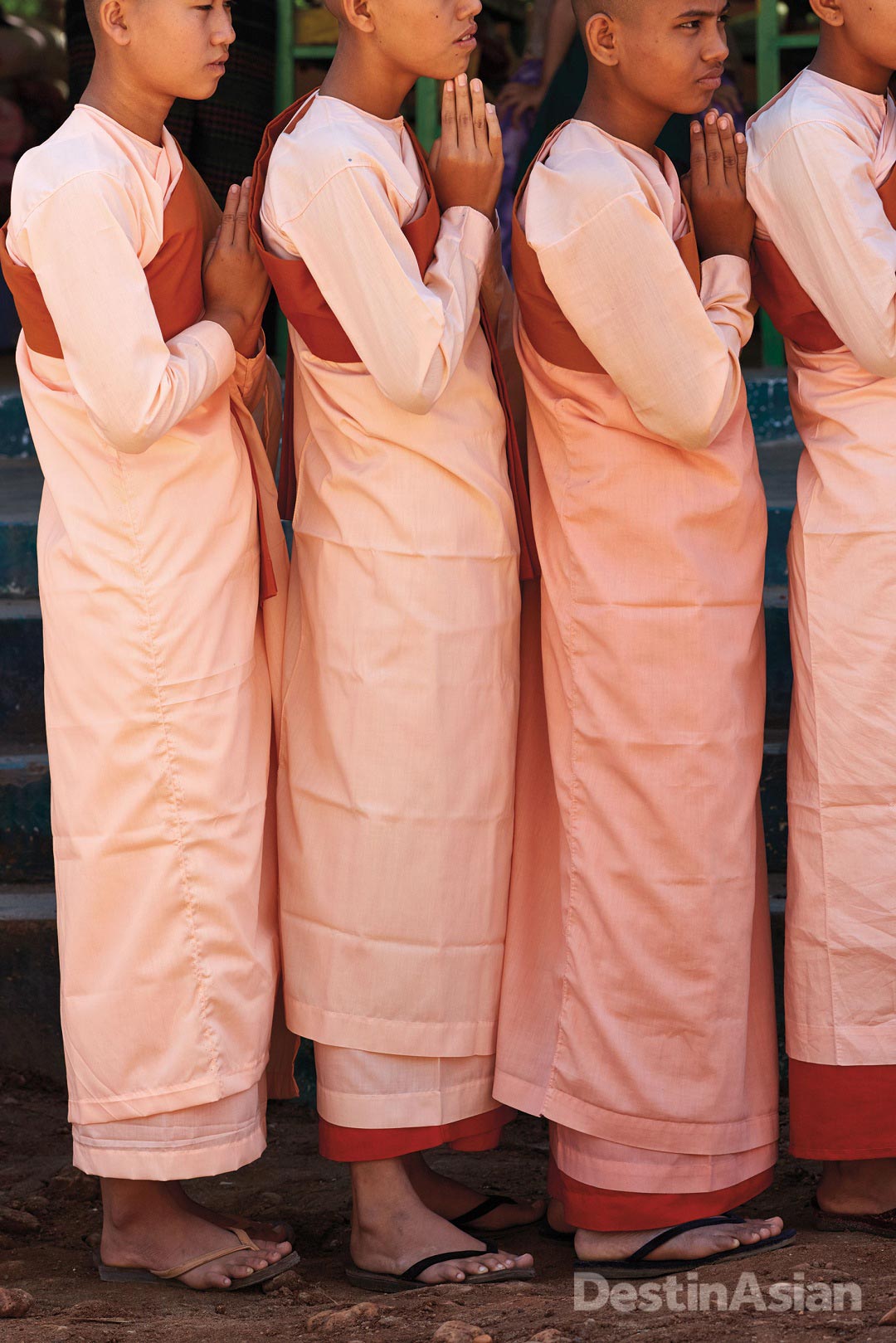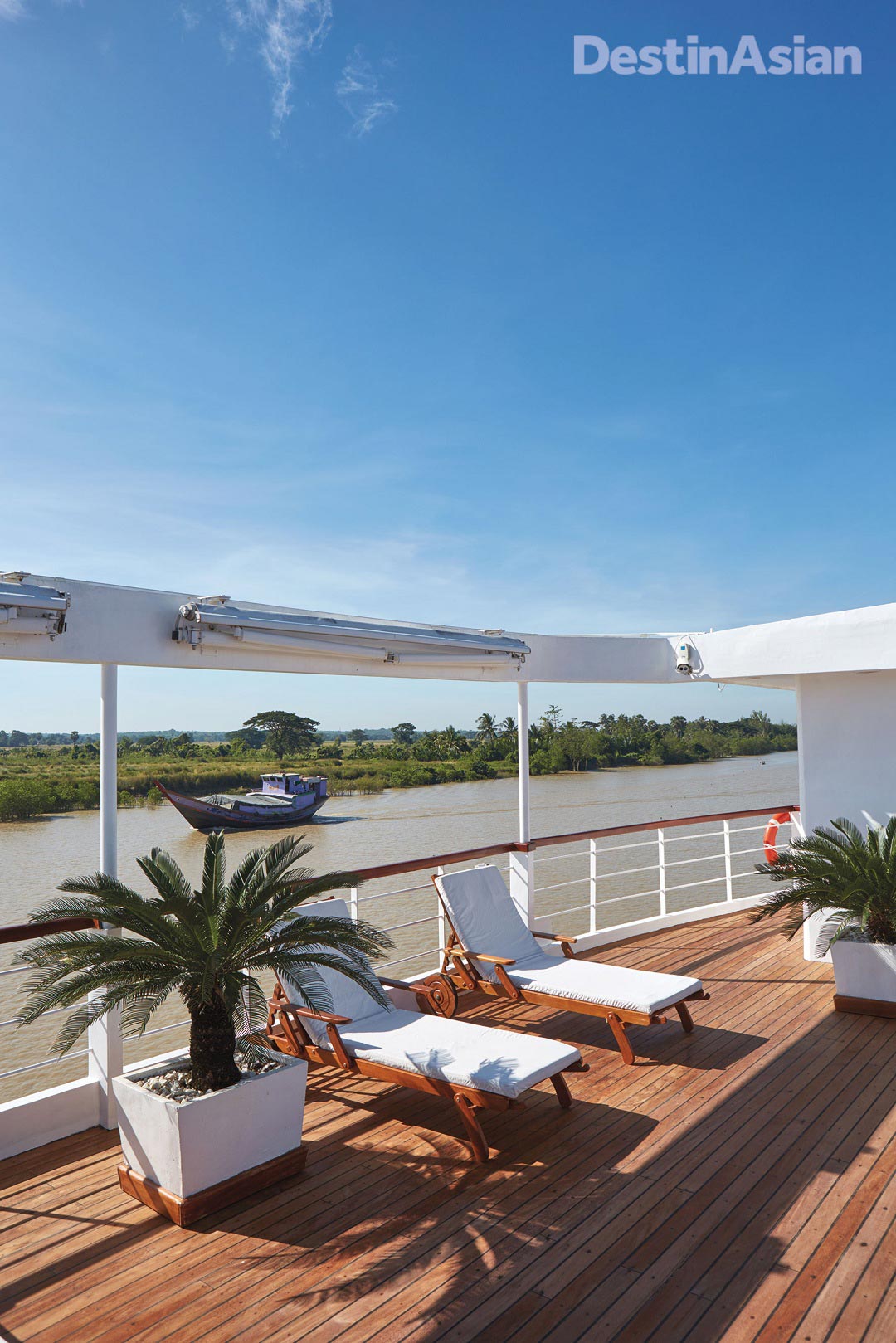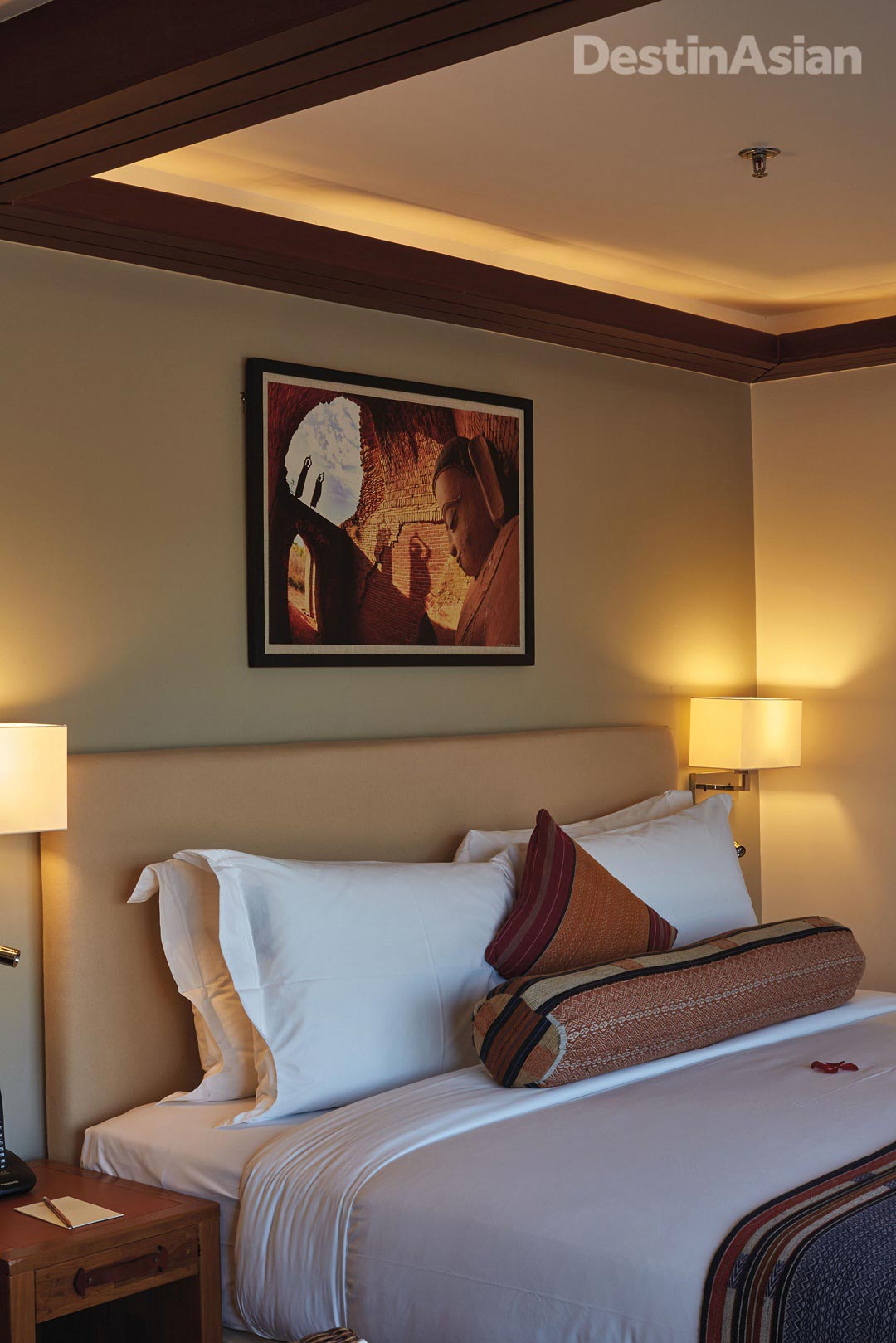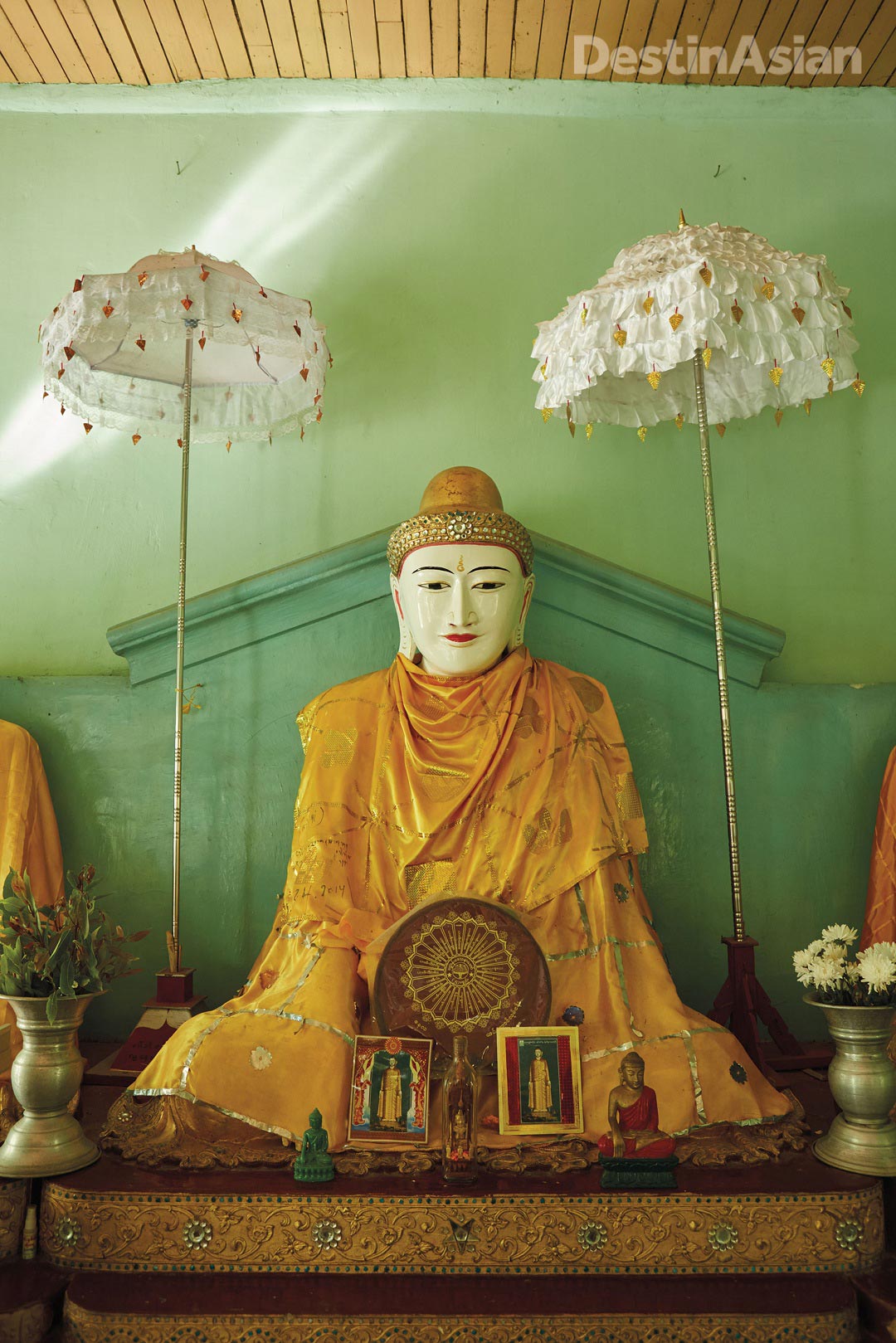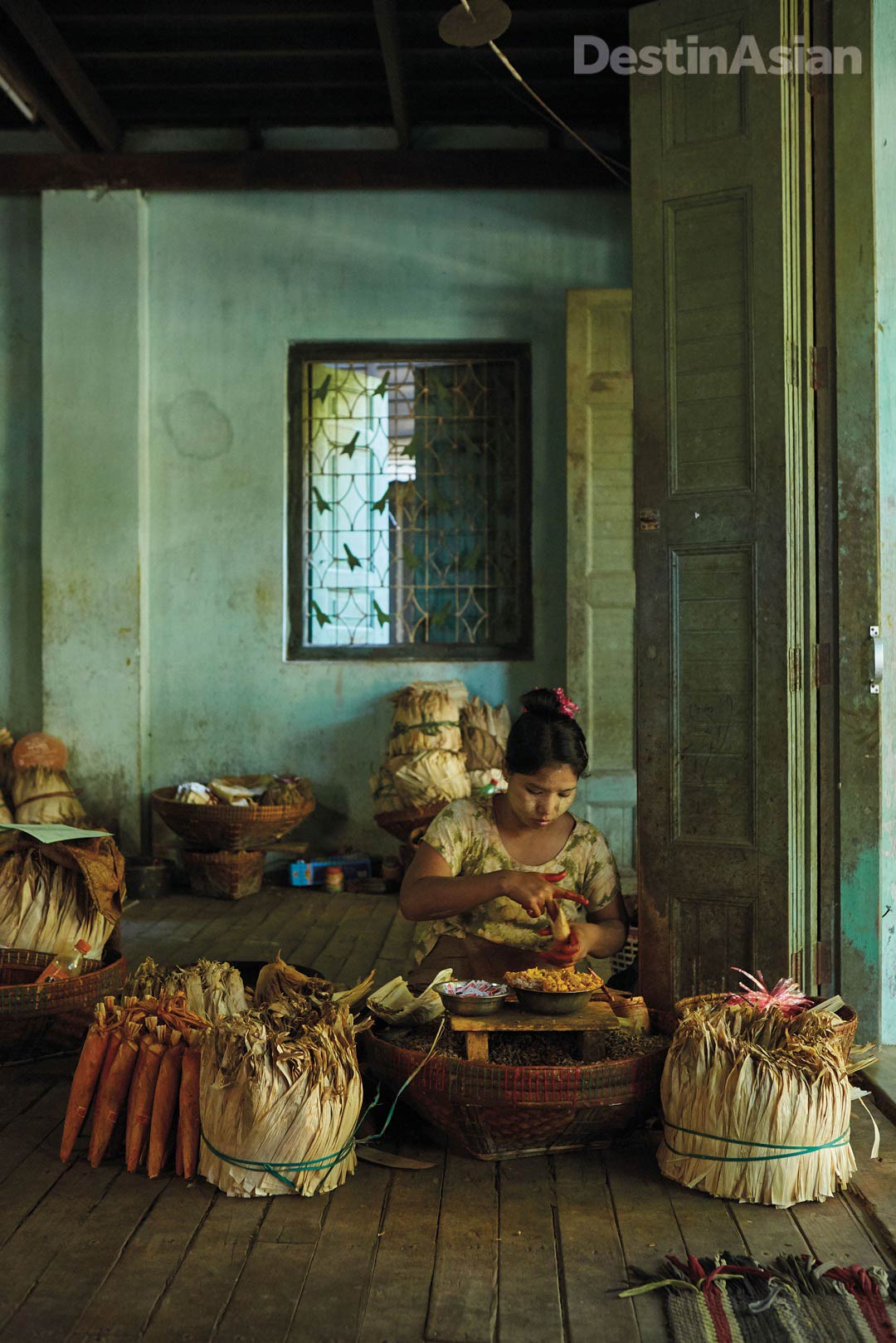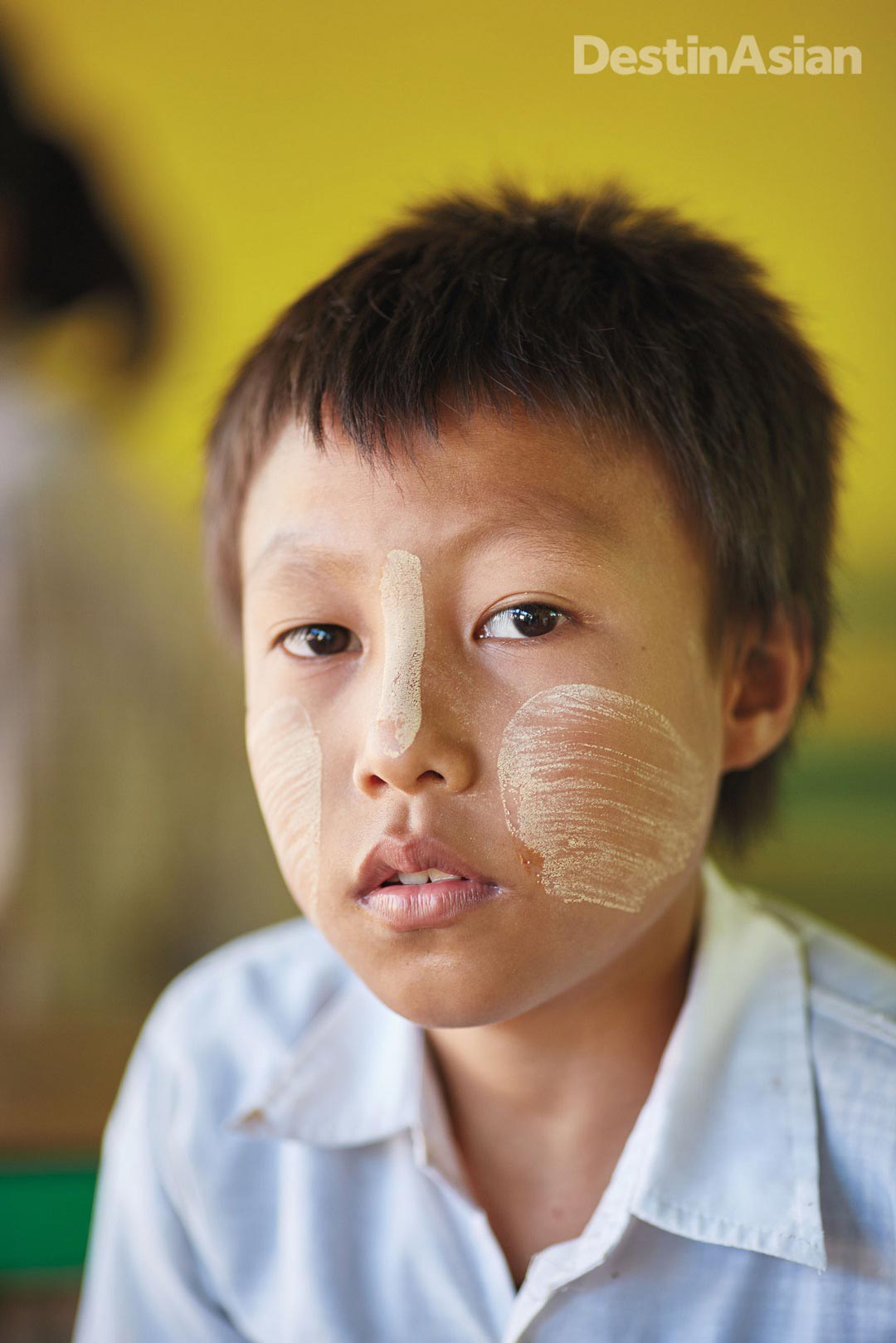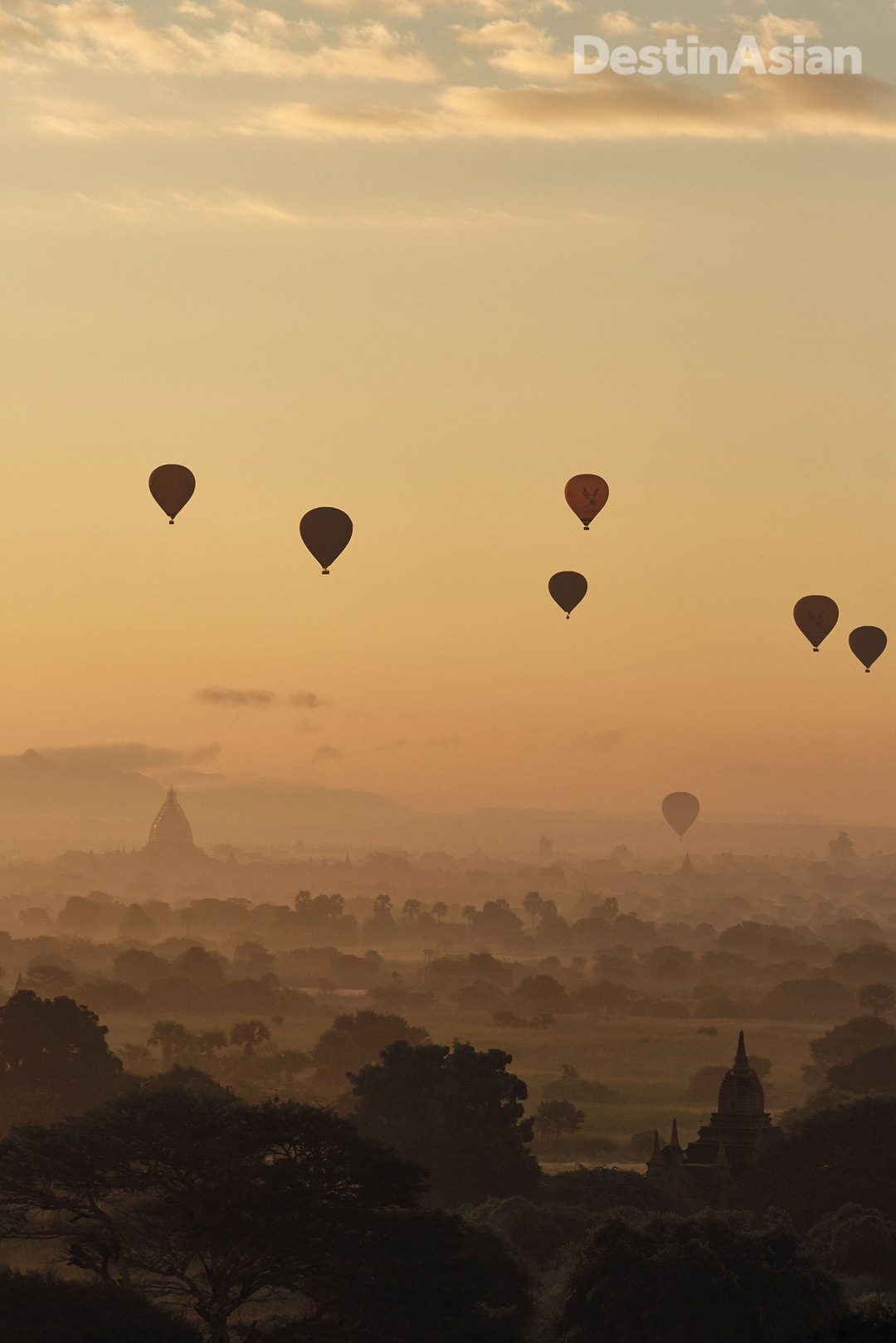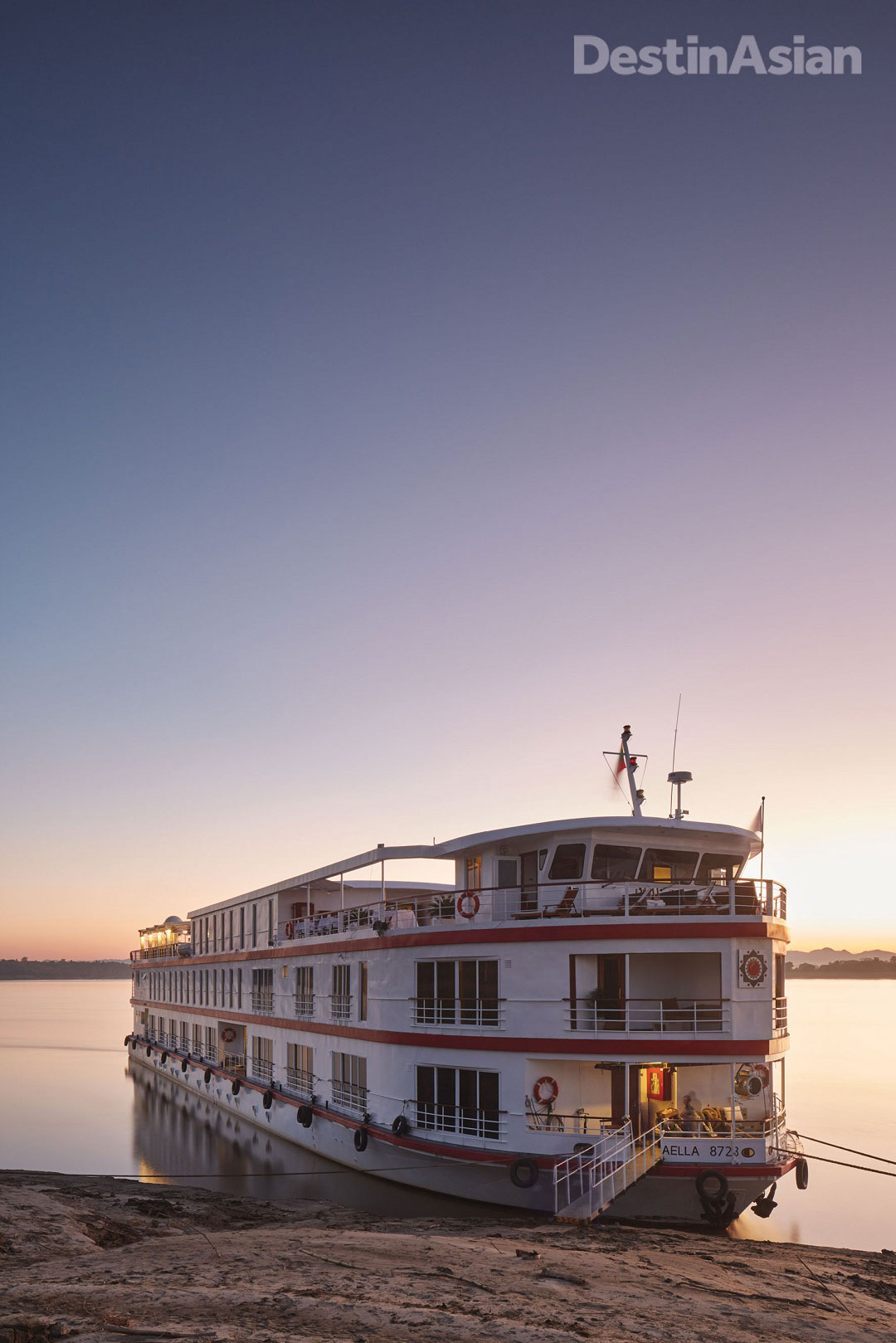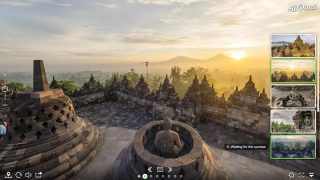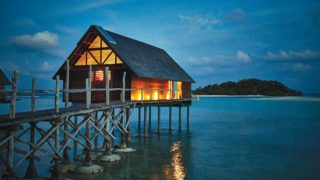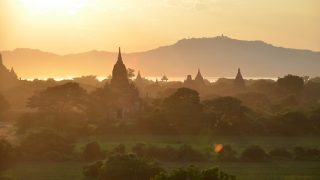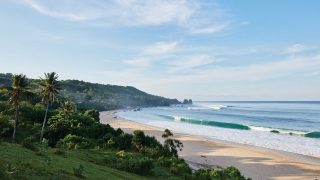A leisurely cruise up Myanmar’s Irrawaddy River gives passengers plenty of time to take in the bucolic scenery, glinting pagodas, and Burmese hospitality at its best.
Photographs by Martin Westlake
“We call this time of day a kyi tan hla chain,” says Soe Kyaw Thu, a bespectacled young man from Bagan with an immaculately tied longyi and a wide grin. “It means ‘the perfect time for ugly things.’ ”
We’re standing on a darkening riverbank at a bend in the Irra-waddy near Gwechaung village, a dusty hamlet whose sole distinction is its proximity to a ruined 19th-century fort built to ward off British troop ships. The sun, deep-orange and fat, is sinking below a distant line of palm trees on the far shore, casting a mellow, slanting light across the cracked earth at our feet. It’s an undeniably gorgeous time of day, when even the unbeautiful, to paraphrase Soe, takes on a beautiful quality. Or so I suppose. After five days cruising up the Irrawaddy through the bucolic floodplains of central Myanmar, I haven’t seen much that would qualify as ugly.
Our boat, backlit by the setting sun, is the Orcaella. She’s a 25-cabin vessel run by the Belmond (formerly Orient-Express) group, which also operates Yangon’s historic Governor’s Residence hotel, where I spent the night prior to embarking. A sister ship to the larger Road to Mandalay, which has been ferrying passengers between Bagan and Mandalay since 1996, the Orcaella was launched almost four years ago to offer longer and more intimate cruises, including trips along the shallower reaches of the upper Irrawaddy and its tributary the Chindwin when the rivers are at their highest in August and September. Constructed in a Yangon shipyard, the Orcaella is not as pretty as her sharp-prowed, German-built older sibling. But what she lacks in outward elegance is more than compensated for by the roomy cabins, appointed with sliding glass doors that open onto Juliet balconies, tasteful wicker and hardwood furnishings, and the biggest en-suite bathrooms I’ve yet to see on a riverboat. As for intimacy, we have that in spades. There are only 17 passengers on this late November cruise, just a third of the boat’s capacity. And with 54 staff and crew aboard, service is especially coddling.
River travel is an unhurried affair, and it attracts an equally sedate demographic; apart from my photographer friend Martin Westlake, our fellow passengers are elderly couples from Switzerland, Britain, Canada, and Australia. Martin and I, both in our early 50s, are quickly dubbed “the young ’uns.” But they’re a game bunch, showing up in numbers for sunrise yoga sessions and afternoon tai chi lessons on the pool deck; eagerly attending the daily lectures on Burmese culture, history, and politics given by Soe, our cruise director; and trundling down the Orcaella’s gangplank each morning for the day’s shore excursion. Even the seventysomething Englishwoman with the bad hip doesn’t miss an outing.
And I don’t blame her. An eight-night trip on a 65-meter-long river cruiser with sketchy Wi-Fi requires as many diversions as you can get. That’s perhaps particularly true on this part of the Irrawaddy (also spelled Ayeyarwady), an almost 600-kilometer stretch between Yangon’s Twante Canal and Bagan. Though pretty enough, the scenery we drift past at a steady seven knots appears unchanged from one day to the next—a flat latte-colored river bordered by flat green countryside broken only by the occasional village, pagoda, or high-embanked town, with the distant hills of the Arakan Mountains teasingly glimpsed to the west.
By day three—the only day of the cruise without a trip ashore —a few of us are beginning to feel restless. The Orcaella has anti-cipated this. A “famous astrologer” has been brought onboard to read palms throughout the day. (To his wife’s annoyance, Brian from Byron Bay is told he will have an affair in the next few months, providing us with a running joke for the rest of the cruise.) Before lunch, chef Yuri, a talented young Thai from Udon Thani, gives a cooking demonstration, headlining it with a Burmese tea-leaf salad. In the afternoon, Soe shows us how to tie a longyi. And we get to keep our longyis because we’re expected to wear them at a cocktail party that evening.
There’s also an impromptu entertainment. After dinner— delicious as ever—a troupe from the village we’ve tied up to, Lakponbu, performs a dragon dance for us on the sun deck. “This is so special,” Soe tells me. “We didn’t ask them to do this. They just wanted to.” The dragon, animated pantomime horse–style by a pair of wiry male dancers, looks more like a deranged llama, and it spends much of the performance biting at imaginary flies on its hind quarters. But the dancers give it their all, bounding across the ironwood deck to the accompaniment of a cane flute and drum. Only later do I notice that the entire village has gathered on the embankment to watch. Whether they’re more entertained by the dance or by the sight of us in our poorly tied longyis, I can’t say.
By day four I’ve settled in to the slow rhythm of our progress. When I’m not thumbing through books in the lounge’s small library or lingering over a meal in the restaurant, my perch of choice is a rattan lounger in front of the wheelhouse, where the snap of a pendant in the warm afternoon breeze provides a counterpoint to the slap of water against the Orcaella’s bow two decks below. Here I try striking up conversations with the captain, Thein Tun, a reticent but ever-smiling riverman who’s piloted craft on the Irrawaddy for 40 years. Or I spend my time observing the other traffic on the river, mostly fishing canoes, gold-panning boats, and coal and gravel barges so overloaded they look ready to sink. Occasionally, I scan the water hopefully for a sight of the Orcaella’s namesake, the Irrawaddy dolphin, a beakless cetacean belonging to the genus—you guessed it—Orcaella. But I look in vain. Though they’re found elsewhere in Southeast Asia and along the Bay of Bengal, these adorable, smiley-faced creatures are only ever seen in the upper reaches of the Irrawaddy, and even there they are increasingly rare. In one of his daily lectures, Soe somberly informs us that only 75 of them survive in the wild, and that’s likely an optimistic estimate.
But we do see plenty of pagodas. Even before arriving at the temple-festooned plains of Bagan, we tie up at Pyay to visit the Shwesandaw Pagoda, an important pilgrimage site believed to enshrine a couple strands of the Buddha’s hair. As at the Shwedagon in Yangon, there are creaky elevators at the ready to carry us up to the hilltop complex, where, between prayers, a throng of worshippers pose for photo ops in front of reclining Buddhas and the gold-plated main stupa itself, which towers some 40 meters above the plaza. Two days later at Magwe, a fleet of waiting tuk-tuks zips us to Myathalon Pagoda after a brief tour of the town’s central market. Perhaps zip is not entirely accurate. On the final climb to the riverside pagoda, the tuk-tuk Martin and I are in breaks down, its whining two-stroke engine unable to bear the strain of our combined weight. Much to the amusement of onlookers, we get out and push.
Our Magwe excursion also includes a stop at a monastic school that Belmond supports through donations. It’s run by a pink-robed senior nun who has her students line up in a row to collect the stationery kits that the boat has organized. Then they sing us a song. It all feels a bit one-sided, but the kids seem happy enough with their new notepads and rulers. Plus, you can’t help but admire Belmond’s commitment to community outreach in Myanmar, where, despite the winds of political change—the country’s first democratically elected government since 1962 took office last April, led by Nobel Peace Prize laureate Aung San Suu Kyi—poverty lingers, particularly in the countryside. Tourism clearly has a role to play in addressing this. And Belmond does its share. Among its many initiatives over the years, the company has run a free clinic in Bagan since 2011, and is in the process of building a hospital there. It also donates water pumps, medical supplies, and solar panels to villages along both the Irrawaddy and the Chindwin. Passengers may make contributions as they wish, and most do.
On day five I awake from an afternoon nap and groggily realize that the boat has stopped. Throwing open the curtains, I look out onto a sunbaked expanse of cracked, fissured earth and a bunch of listless oxen tethered to wooden carts. Where are we now?
The answer is Gwechaung. An hour later, squeezed into the carts, we’re jouncing along the village’s dirt road and then ascending an earthen defile that looks like it was recently cut into the hillside. At the top of the hill is Gwechaung Fort. This was built by European engineers at the behest of King Mindon following Britain’s annexation of Lower Burma—pretty much everything south of Magwe—in 1853. Mindon didn’t live to see his kingdom fall, but his son and successor, Thibaw, did. In 1885, the swift advance upriver of a fleet of British barges and paddle steamers met with little resistance, and the royal capital of Mandalay was captured without a fight. Thibaw, the last king of Burma, ended his days in exile in India.
Today, the fort is an evocative ruin of crumbling brickwork. While pointing out the battery’s former elephant corrals and gun emplacements, Soe spices up his commentary with a digression about the amorous excesses of the country’s bygone royalty. “King Mindon had 45 consorts and 70 children. Ladies, can you imagine?” They can’t.
Martin and I skip the oxcart ride back to the boat, opting instead for a leisurely walk through the village. It’s a tiny place of maybe 20 stilted, wooden houses. A line of kids, their cheeks smeared with the ubiquitous cosmetic paste known as thanaka, soon forms behind us, giggling as we march back to the river. The sun is low now, and apparently that means bath time, as a group of young men and women have gathered in a reed-fringed lagoon for their afternoon wash. There’s nothing immodest about it—they’re all wrapped in sodden longyis, the women’s tied under their armpits. Martin stops to take photos. No one seems to mind. “Mingalaba,” we say, proffering the traditional Burmese greeting. It’s a magical word that never fails to elicit a warm response. “Mingalaba,” they call back cheerily, before resuming their ablutions.
After the towns we’ve visited so far—Danuphyu, Pyay, Magwe—Salay is quite unexpected: a dozy collection of moldering colonial villas built in the late 1800s and early 1900s by the Burmah Oil Company to house its British rig workers. Most appear unlived in or used for storage, lending the place an air of abandon. One exception is Salay House, a lovingly refurbished riverside warehouse dating to 1901 that now does triple duty as a shop, restaurant, and unofficial museum. The owner, Ma Khine, is a former tour agent from nearby Bagan who—she hopes—is at the vanguard of Salay’s revival. “It’s beautiful here on the river, surrounded by so many architectural treasures,” she says. “Salay was once a prosperous place. I don’t see why it can’t be again.”
Salay’s trove of treasures includes dozens of monasteries and shrines, as the town has been an active religious center since at least the 12th century, when the Kingdom of Bagan was at its height. Among them is Yot Son Kyaung, a beautiful teak building dating to 1882. Now a museum, its creaky halls are full of elaborate wood carvings and Buddhist statuary. But what catches my eye is a wooden frieze at the front, which appears to depict a lecherous old man attempting to disrobe a young lady. A plaque below reads BLAME THE SENSUALITIES. Soe explains, “This monastery was commissioned by a man named U Pho Kyi, a very rich man and a very naughty man who wanted to atone for his sins. This panel was made by the monks to chastise him. U Pho Kyi was a womanizer. He had many, many affairs.”
We all look at Brian.
From Salay, it only takes a couple of hours for the Orcaella to chug up to Bagan. This is the high point—both figuratively and geographically—of our cruise. Set on a vast, arid plain on the river’s east bank, Bagan served as the capital of successive Burmese kings from the ninth to 13th centuries. During this era, it became fashionable among the city’s elite to build pagodas, temples, and other religious monuments that grew grander and more elaborate over the generations. Marco Polo, who visited shortly before Bagan fell to Mongol invaders in 1287, called it “one of the finest sights in the world.”
It still is. More than 2,000 temples and pagodas survive from that period, and while most of their plasterwork and gold embellishments are long gone, the brickwork structures that remain are exalting. We explore them that afternoon by horse cart, but even after an hour we’ve barely scratched the surface. The day ends at a small temple back by the jetty, where the boat has arranged a candle-lighting ceremony. As twilight approaches, the candles—seemingly hundreds of them—are lit up one by one. It’s magical.
“Ugly time,” I say to Soe.
“Yes indeed, Mr. Chris,” he replies.
The only way to truly appreciate the scale of Bagan is to see it from above. So the next morning, Martin and I are up early for a sunrise flight in a hot-air balloon. This is not included in the price of the cruise, but it’s well worth paying extra for. Rising through the morning fog, our big red balloon—piloted by an Englishman named Andy and owned by an outfit called Balloons over Bagan—is soon floating on a gentle breeze above the pagoda-dotted plains, the glory of ancient Bagan spread out before us. The Irrawaddy is there too, bending northward toward Mandalay. I can’t make out the Orcaella, but I know she’s moored down there somewhere. Tomorrow or the next day, the boat will turn downriver for the long journey back to Yangon. And a part of me wants to go with her.
THE DETAILS
The Orcaella’s eight-night “Jewels of the Ayeyarwady” cruise from Yangon to Bagan costs US$6,870 per person and operates in January–March and October–November. At other times of the year, the boat is based out of Mandalay, from where it cruises up the Chindwin River as well as to Bhamo on the Irrawaddy’s northern reaches.
Where to Stay
The Orcaella’s morning departure from Yangon means you’ll need to arrive the day before. Spend the night at the Belmond Governor’s Residence: built in 1920, the hotel centers on a colonial-style mansion that overlooks lily ponds and a sprawling garden. The nightly Burmese curry buffet is not to be missed (95-1/229-860; doubles from US$518).
Hot-air Ballooning
Flights with Balloons over Bagan start at US$330 per person and last for up to an hour, depending on the wind. A must-do.
This article originally appeared in the February/March 2017 print issue of DestinAsian magazine (“Bagan Bound”).

